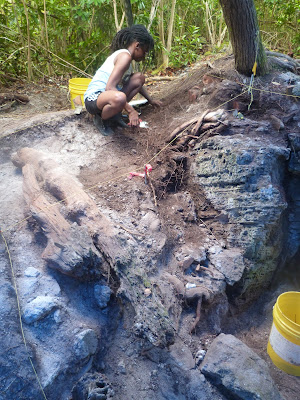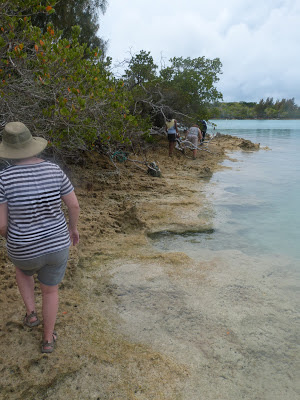Through the rubble layer and into the house floor...
 |
| Kristina, Jillian, Jonathan, me, Anima, Leigh, and Krystl |
 |
| Stratigraphic changes don't get much clearer than this |


We continued to clear away the considerable pile of stones and rubble abutting the back wall cut of the Oven Site, which extends at least six feet from the corner. Digging on such a sharp slope is challenging, as are the thick roots from the Mexican Pepper and Allspice trees that had claimed the hillside for themselves. We completely uncovered two cedar tree sections that had been buried for who knows how long (yet are entirely sound, timber-wise - a testament to their resistance to rot) and were thus able to remove them and start on the next layer beneath.
 |
| Walking to the bay at low tide |
 |
| SW corner of first ruin |
While the students returned the way they had come along the coast, I (foolishly) thought it might be easier to return east through the forested area to the sound of the ruins. Big mistake! The tree cover quickly grew densely tangled with fallen Mexican Peppers - but not before I found a very intriguing curved feature carved into the bedrock) and forced me into high open fields - which were a veritable sea of poison ivy. I nearly fell into a small but very deep quarry almost completely covered by fallen brush, after which I concluded that discretion is the better part of valour - and returned to the foreshore route only a couple dozen yard east of where I'd started! Still, some very exciting finds that are likely coterminous or post-date the Forbes family's period of ownership (1758-1850s) and might represent the homes of Forbes slaves - or freedmen after 1834. This cluster of buildings looks very promising, perhaps for years 4 and 5 of the Smiths Island project - and there are likely to be other sites on the BNT part of the island - documentary evidence suggests at least three more out there on their 20 acres. And today Jillian earned her field school t-shirt for finishing her third day of volunteering! Folks out there - I still have plenty of t-shirts left, so come on out with us and get your trowels dirty in the name of history!


We actually have enough artifacts now to have warranted a lab day, washing up the newly recovered ones and bagging up those Kristina already washed.
 On the home front, there has been much joy in our condo. We've all hit the end of our clean clothing supplies and have jockeyed for the washer and drier. Jonathan found a remote-control helicopter in one of the rooms and is now tormenting Kristina with it (it fires missiles in mid-flight!). The gray cat that has adopted us and is trying valiantly to get into the condo somehow can climb up on our balcony and bats the windows like a jazz drummer in the early mornings. I've named him Dauntless...
On the home front, there has been much joy in our condo. We've all hit the end of our clean clothing supplies and have jockeyed for the washer and drier. Jonathan found a remote-control helicopter in one of the rooms and is now tormenting Kristina with it (it fires missiles in mid-flight!). The gray cat that has adopted us and is trying valiantly to get into the condo somehow can climb up on our balcony and bats the windows like a jazz drummer in the early mornings. I've named him Dauntless...We continue to enjoy excellent weather and the water has warmed up to 78 deg. F. If the megaship that just left hadn't churned up the water all along the North Shore, we'd have excellent snorkeling. My ambition to go on a diet has been severely challenged by the Most Excellent foods that Somers Market sends us daily - way better than any field school I've ever been on! In the past three days we've enjoyed curried goat, roast lamb, honey mustard chicken, fried Bermuda fish, garlic roast potatoes, mac and cheese, chili, shepherd's pie, meatballs, jerk chicken, peas and rice, bread and butter pudding, fresh fruit and salad, and fried plantain - a global cuisine. Chef Aroop is a culinary genius and we are his grateful admirers. Oh, and to celebrate the end of our second week, we had gelato at Wahoos - another great St. George's treat. Digging tomorrow with at least one new volunteer and then its Seventeenth-Century Day on Sunday...
Oh, by the way - for anyone who would like to read a student's perspective of the same dig, check out Kristina's blog, http://archiediva.wordpress.com/



.jpg)
Comments